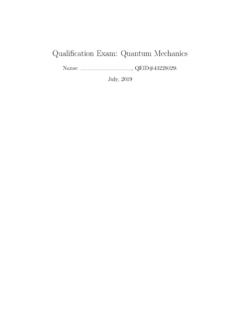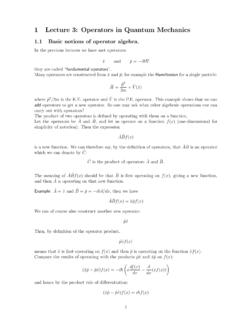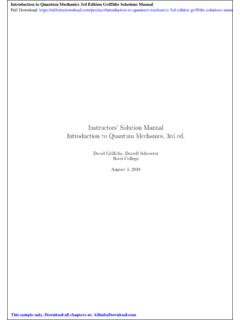Transcription of Introduction to path integrals - McGill University
1 1 Introduction to path integralsv. January 22, 2006 Phys 719 - M. HilkeCONTENT Classical stochastic dynamics Brownian motion (random walk) quantum dynamics Free particle Particle in a potential Driven harmonic oscillator Semiclassical approximation Statistical description (imaginary time) quantum dissipative systemsINTRODUCTIONPath integrals are used in a variety of fields, includingstochastic dynamics, polymer physics, protein folding,field theories, quantum mechanics , quantum field theo-ries, quantum gravity and string theory. The basic ideais to sum up all contributing paths. Here we will overviewthe technique be starting on classical dynamics, in par-ticular, the random walk problem before we discuss thequantum case by looking at a particle in a potential, andfinish with an example of a quantum dissipative system,where this technique bares all its STOCHASTIC DYNAMICSThe classical equation of motion for a particle in afluctuating environment is simply given bymdvdt=F(t) v/B(1)wheremis the mass,vthe velocity andBdescribes thefriction of the particle.
2 This equation is the Langevinequation ifF(t) is a fluctuating force. These equa-tions are often difficult to solve and one possibility isto look at the probability density (x, t) instead. Thisapproach leads to expressing in terms of a master-equation (Fokker-Planck) which takes on the followingform: t= x( 1 ) + 2 x2( 2 )(2)with 1(x) and 2(x) the first and second moments ofthe transition approach is to use path integrals . We will usethe example of a simple brownian motion (the randomwalk) to illustrate the concept of the path integral (orWiener integral) in this RANDOM WALKThe discrete random walk describes a particle (or per-son) moving along fixed segments for fixed time intervals(of unit 1). The choice of direction for each new segmentis random. We will assume that only perpendicular di-rection are possible (4 possibilities in 2D and 6 in 3D).The important quantity is the probability to reachxattimet, when the random walker started atx at timet :P(x, t;x , t ).
3 (3)For this probability the following normalization condi-tions apply:P(x, t;x , t) = x,x and for (t > t ) xP(x, t;x , t ) = 1.(4)This leads toP(x, t+ 1;x , t ) =12D P( , t;x , t ),(5)where represent the nearest neighbors ofx. This issolved by the Fourier transform:P(x, t, x , t ) = dDk(2 )Deikx P(k, t),(6)which leads to P(k, t+1) =1DD =1cos(k ) P(k, t) with P(k, t ) =e ikx .(7)Hence,P(x, t;x , t ) = dDk(2 )Deik(x x )(1DD =1cos(k ))t t ,(8)where we used 7 iteratively. Now, instead of using theprobability we introduce the probability densityp=P/aD, whereaia the step size, which will allow us totake the limita 0, for the continuous case with thevariable change (k ak,x x/a). Hence,2p(x, t;x ,0) = dDk(2 )Deik(x x )(1DD =1cos(ak ))(t t )2D/a2 'e tk2,(9)where we used1D D =1cos(ak )'(1 a2k2/2D+ ).Hence,p(x, t;x ,0) = dDk(2 )Deik(x x ) tk2=14 tD/2e (x x )24t,(10)which is the standard diffusion equation.
4 The normaliza-tion of the probability density requires dDxp(x, t;x , t ) = 1(11)andlimt 0p(x, t;x , t ) = D(x x )(12). It is now possible to describe the evolution from aninitial point (xi,0) to a final point (xf, t) by inserting anintermediate point (x1, t1) and integrating over it, ,p(xf, t;xi,0) = dDx1p(xf, t;x1, t1)p(x1, t1;xi,0) (0< t1< tf).(13)We can perform a similar decomposition forninterme-diate points, withxf=xnandx0=xi. This then leadsto thesummation over n paths, which is the mainidea of thepath integral. Thus, using (13) and (10) weobtainp(xf, t;xi,0) = n 1 j=1dDxj4 (tj+1 tj)D/214 tD/21e 14 n 1j=0(xj+1 xj)2tj+1 tj.(14)Sincen 1 j=0(xj+1 xj)2tj+1 tj= t0ds x2,(15)we define thepath integralasp(xf, t;xi,0) = xfxiDx(s)e 14 t0ds x2.(16)HereDdenotes the multiple integrals defined in (14) andrepresents the sum over all paths (Wiener integral). Wewill see in the next sections that a very similar expressionexists in quantum mechanics .
5 In classical systems thispath integral is useful when there exist many ways to getform one point to the other (like in stochastic processes)and where it is then necessary to sum over all MechanicsFeynman Path Integral withSplitting the time evolution in 2: Written in eigenfunction basis: Free particle: usingand In terms of the classical action: (classical free path) Particle in a potential:usingand {0 cThe Feynman path integralDriven harmonic oscillator:= Classical path+ quantum fluctuationsfluctuationsClassical path with;Hence,Normalization:butand Semiclassical approximation:0 with Imaginary time (statistical properties):whereButis the quantum partition functionShows that for hencewithThe equilibrium density operator:Applying this to the harmonic oscillator:Dissipative Systems:{Effective action:(the density matrix)(initially independent)(tracing out the environment)(tracing out the environment) Path integrals and Their Application toDissipative quantum SystemsGert-Ludwig IngoldInstitut f ur Physik, Universit at Augsburg, D-86135 Augsburgto be published in Coherent Evolution in Noisy Environments ,Lecture Notes in Physics, Springer Verlag, Berlin-Heidelberg-New YorkPath integrals and Their Application toDissipative quantum SystemsGert-Ludwig IngoldInstitut f ur Physik, Universit at Augsburg, D-86135 Augsburg, Germany1 IntroductionThe coupling of a system to its environment is a recurrent subject in this collec-tion of lecture notes.}}
6 The consequences of such a coupling are threefold. First ofall, energy may irreversibly be transferred from the systemto the environmentthereby giving rise to the phenomenon ofdissipation. In addition, the fluctuatingforce exerted by the environment on the system causesfluctuationsof the systemdegree of freedom which manifest itself for example as Brownian motion. Whilethese two effects occur both for classical as well as quantum systems, there existsa third phenomenon which is specific to the quantum world. As aconsequenceof the entanglement between system and environmental degrees of freedom acoherent superposition of quantum states may be destroyed in a process referredto asdecoherence. This effect is of major concern if one wants to implement aquantum computer. Therefore, decoherence is discussed in detail in Chap. computation, however, is by no means the only topic where thecoupling to an environment is relevant.
7 In fact, virtually no real system can beconsidered as completely isolated from its surroundings. Therefore, the phenom-ena listed in the previous paragraph play a role in many areasof physics andchemistry and a series of methods has been developed to address this approaches like the master equations discussed in Chap. 2 are particularlywell suited if the coupling to the environment is weak, a situation desired inquantum computing. On the other hand, in many solid state systems, the envi-ronmental coupling can be so strong that weak coupling theories are no longervalid. This is the regime where the path integral approach has proven to be would be beyond the scope of this chapter even to attempt togive a com-plete overview of the use of path integrals in the description of dissipative quan-tum systems. In particular for a two-level system coupled toharmonic oscillatordegrees of freedom, the so-called spin-boson model, quite anumber of approx-imations have been developed which are useful in their respective parameterregimes.
8 This chapter rather attempts to give an Introduction to path integralsfor readers unfamiliar with but interested in this method and its application todissipative quantum this spirit, Sect. 2 gives an Introduction to path integrals . Some aspectsdiscussed in this section are not necessarily closely related to the problem ofdissipative systems. They rather serve to illustrate the path integral approachand to convey to the reader the beauty and power of this approach. In Sect. 32 Gert-Ludwig Ingoldwe elaborate on the general idea of the coupling of a system toan path integral formalism is employed to eliminate the environmental degreesof freedom and thus to obtain an effective description of the system degree offreedom. The results provide the basis for a discussion of the damped harmonicoscillator in Sect. 4. Starting from the partition functionwe will examine severalaspects of this dissipative quantum interested in a more in-depth treatment of the subject of quantumdissipation are referred to existing textbooks.
9 In particular, we recommend thebook by U. Weiss [1] which provides an extensive presentation of this topictogether with a comprehensive list of references. Chapter 4of [2] may serve as amore concise Introduction complementary to the present chapter. Path integralsare discussed in a whole variety of textbooks with an emphasis either on thephysical or the mathematical aspects. We only mention the book by H. Kleinert[3] which gives a detailed discussion of path integrals and their applications indifferent Path IntroductionThe most often used and taught approach to nonrelativistic quantum mechan-ics is based on the Schr odinger equation which possesses strong ties with thethe Hamiltonian formulation of classical mechanics . The nonvanishing Poissonbrackets between position and momentum in classical mechanics lead us to in-troduce noncommuting operators in quantum mechanics . The Hamilton functionturns into the Hamilton operator, the central object in the Schr odinger of the most important tasks is to find the eigenfunctions of the Hamiltonoperator and the associated eigenvalues.
10 Decomposition ofa state into theseeigenfunctions then allows us to determine its time an alternative, there exists a formulation of quantum mechanics basedon the Lagrange formalism of classical mechanics with the action as the cen-tral concept. This approach, which was developed by Feynmanin the 1940 s[4,5], avoids the use of operators though this does not necessarily mean that thesolution of quantum mechanical problems becomes simpler. Instead of findingeigenfunctions of a Hamiltonian one now has to evaluate a functional integralwhich directly yields the propagator required to determinethe dynamics of aquantum system. Since the relation between Feynman s formulation and classi-cal mechanics is very close, the path integral formalism often has the importantadvantage of providing a much more intuitive approach as we will try to conveyto the reader in the following PropagatorIn quantum mechanics , one often needs to determine the solution| (t)iof thetime-dependent Schr odinger equationi~ | i t=H| i,(1)Path integrals and quantum Dissipation3whereHis the Hamiltonian describing the system.






